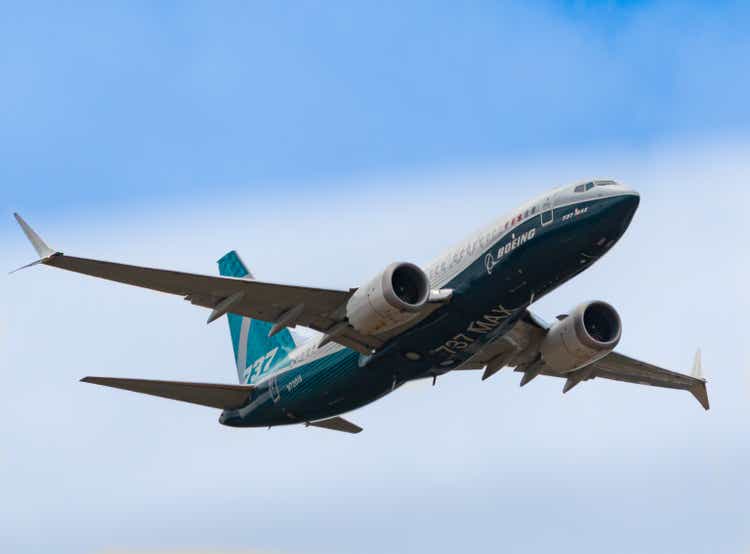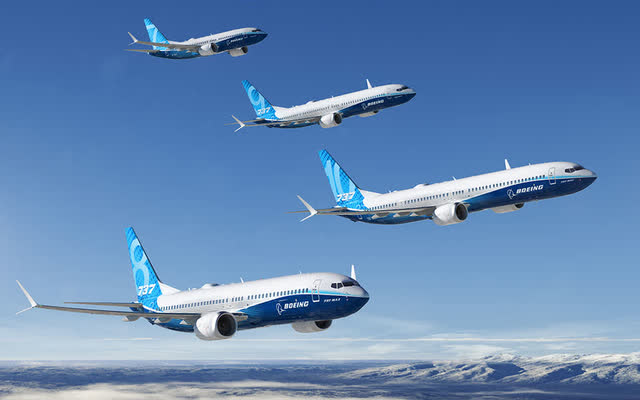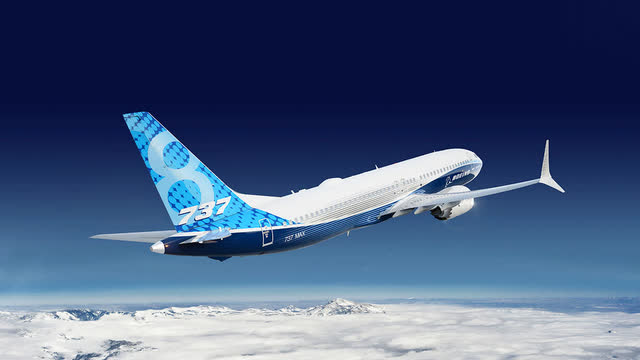Oriaz
Boeing (NYSE:BA) executive Brian West recently sent a strong signal to China during the Morgan Stanley 10th Annual Laguna Conference, sharing that Boeing had been remarketing Boeing 737 MAX aircraft that had been intended for Chinese customers. To me it seems that with the comments from CFO Brian West and CEO Dave Calhoun, Boeing tried to force CAAC (Civil Aviation Administration of China) to accelerate the process of clearing the MAX for service in China.
Today, the news broke that a day prior to the Morgan Stanley 10th Annual Laguna Conference, there actually had been a meeting with the Chinese regulator, which might put things in a different perspective. That is why I am writing this report for investors and I will also be addressing some misconceptions that I came across in the vivid comment section of my previous report with nearly 350 comments from readers and responses.
The Boeing 737 MAX Is Safe
The Boeing 737 MAX Family (The Boeing Company)
One of the subjects that is circled by misconceptions is the safety of the MAX. Some people say the MAX has not been sufficiently tested or even go as far as claiming China is not taking MAX aircraft from Boeing because the aircraft is not safe to fly while there is another group that calls the MAX the safest plane in the skies.
On the subject of insufficient testing, it seems that some investors are still equating the current MAX to the MAX as it is today. The initial MAX design had a flawed MCAS architecture relying on a single angle of attack sensor feeding information to the MCAS (Maneuvering Characteristics Augmentation System), which was presented as a subsystem of the Speed Trim System. The problem with MCAS was that in case of failure of the sensor, incorrect information would be fed to the MCAS resulting in erroneous movement of the horizontal stabilizer, affecting the ability to pitch the aircraft. Next to that, flight crews were not informed and trained on MCAS or any failure scenario for that system. Throughout the grounding of the MAX, Boeing has worked on informing flight crews and producing appropriate training material regarding MCAS and MCAS was updated. The new updated MCAS design takes input from two angle of attack sensor, significantly improving the robustness of the system, while any disagree in angle of attack readings exceeding a certain threshold as well as the time length of the disagree would turn off the Speed Trim System of which MCAS is part while alerting crews. Additionally, MCAS no longer sends a continuous command when the angle of attack is too high, but it sends one signal per instance of the angle of attack threshold value being exceeded and additionally, the stabilizer movement can now be offset by elevator deflection, meaning that the horizontal stabilizer can never be moved by the MCAS to the extent that flight crews cannot offset this by moving their yoke. This results in elevator authority, which is a huge difference with how the system initially functioned.
So, really a lot has changed on the MAX and alleging that the MAX is not safe at present is not something that does not have a base in reality but merely relies on memories of the old system or emotional responses and emotions and investing never go well together. Boeing redesigned the system and the FAA, which looked extremely weak due to its lack of oversight and insights in Boeing’s dealings during certification, thoroughly reviewed the MAX from nose to tail. Some people see that as a token that the MAX is the safest planes. Reality, however, is that the Boeing 737 MAX most likely is the most scrutinized airplane flying around today, but for that aircraft to become the safest, it has to fly a lot of incident-and-accident-free hours.
Why China Is Not Taking Deliveries Of The MAX
The reason for China not taking delivery of the aircraft is also subject of misconception. As I explained above, safety should not be an issue as adequate changes as approved by most aviation administrations have been made. There are also claims that China is not taking planes because airlines are in bad financial shape and on the verge of bankruptcy. China has rapidly closed and opened areas of the country during the pandemic and that doesn’t help the Chinese airline industry and there indeed are concerns about future demand for aircraft in China. However, with the biggest players in China being state-owned, it is unlikely we will see any of the major players go belly up any time soon. Testimony to that is the fact that while Boeing deliveries were halted, deliveries of Airbus (OTCPK:EADSF) (OTCPK:EADSY) aircraft continued and those deliveries to Chinese airlines exceed 260 aircraft for the Airbus A320 family since 2019. If financials were an obstacle, we would likely have seen softer deliveries from Airbus to China as well. Airbus is not handing those aircraft over to customers for free either.
I would say stating that China does not need planes, because the airlines are in poor financial shape is not accurately depicting what drives the delivery stop for the MAX nor is safety.
The underlying reason for the delivery stop in my view is really simple: tensions between the US and China and Boeing got caught in the middle. We can trace the tensions back to current and previous administrations in both countries and you could even trace them back further. However, the trade war between the US and China brought a change in tone and not a positive one. While engaged in a trade war, the Boeing 737 MAX crashes occurred, and it made the 737 MAX an easy target to be politicized. After the second crash of the Boeing 737 MAX, China was the first country to ban the MAX, and while they absolutely were not wrong in their assessment, the move also clearly portrayed the tension between the two superpowers. As the trade war lingered on and no constructive agreement was reached, progress on the MAX recertification took a backseat. The pandemic and a Boeing 737 crash in China, which was likely caused by one of the flight crews, did not aid in accelerating the recertification timeline. The administration change in 2021 was seen as an opportunity to restore relations, but as talks between China and the US were rather disappointing, there was no progress on resolving trade issues, and as the current administration is attempting to further control technology transfer, the gridlock of the MAX remained. Every aviation administration except for the Chinese one has approved the MAX by now, and given the global tensions regarding Taiwan and trade, attributing this to anything other than the existing tension would not accurately depict reality, in my opinion.
Boeing And China Need Each Other
One sentiment that I saw reappear quite often in my initial report is people saying that Boeing should stop doing business with China, and while that might seem like a solution in an escalating situation, sales to China are so big that they cannot be offset by any other geographical region. So, ceasing to do business with China would be devastating to Boeing’s business and its position as a manufacturer of commercial aircraft. Simultaneously, with over 1,000 Boeing single aisle aircraft in China, the Chinese also depend on Boeing, because you don’t transfer your crews from a Boeing flight deck to an Airbus flight deck from one day to the other. China is well aware of this. To continue growing they need Boeing, not just for their airlines but also from manufacturing perspective. Additionally, there is no manufacturer that could step up their production to meet Chinese demand for aircraft.
Prior to the pandemic, China also imposed tariffs on aircraft from the US, but as I pointed out on NPR, the tariffs were bracketed such that effectively no aircraft that China required were affected as China targeted the single aisle aircraft but put the weight brackets such that the MAX deliveries were not affected. I believe it was the pandemic that allowed China to really follow a tougher line on the MAX to push their geopolitical and trade agenda as the urgency to take deliveries of aircraft evaporated.
So, China not taking deliveries has everything to do with the geopolitical landscape and not so much safety concerns or the financial situation of state-owned airlines, in my opinion.
CAAC Responds To Boeing
Boeing 737 MAX 8 (The Boeing Company)
So, with the misconceptions hopefully out of the way I want to focus on China’s response. When Brian West, CFO of The Boeing Company, shared that some aircraft from inventory were now being remarketed to other customers, I noted that this would be a step that would infuriate China and China’s response came in two ways. The first one was the announcement that the CEO of Raytheon Technologies and the CEO of Boeing Defense, Space & Security would be sanctioned, citing their involvement in weapon sales to Taiwan. Considering the timing, just a day after Boeing’s remarks regarding China and the MAX, I would say this once again underlines how the MAX, commercial business and geopolitics are entangled.
The second response was more enlightening I would say. CAAC shared that it held a meeting with Boeing in China and would issue a report soon as questions raised during the meeting were addressed. The response, automatically translated, can be found below:
On September 14, the Civil Aviation Administration of China and Boeing held a special meeting on 737MAX aircraft operation review (i.e. AEG review) in Zhoushan, Zhejiang, aiming to review the improved overall model training specifications of the 737 series. It is reported that after the questions raised at the meeting are resolved, the Civil Aviation Administration of China will release the second revision of the “Boeing 737 Series Aircraft Review Report”, marking that China’s civil aviation industry will soon complete the entire process of resuming the introduction of new 737MAX aircraft.
The full-time AEG reviewers from the Flight Standards Department of the Civil Aviation Administration and the Aircraft Review Center of the Academy of Aviation Science participated in the review. The meeting also invited flight and maintenance technical experts from some airlines, as well as the chief operation inspectors and chief maintenance inspectors of regional administrations. Some personnel from Boeing China and Boeing Zhoushan Completion and Delivery Center provided offline support for the meeting, and the Boeing 737 project and technical team provided online support in Seattle.
On the second day of the special meeting, the delegates also visited the Boeing Zhoushan Completion and Delivery Center.
The response is quite an interesting one likely invoked by remarks from Boeing CFO and the CEO of Boeing stating that he didn’t see a good path forward for another two years on Chinese sales. The release from CAAC also puts a different light on the words of Brian West as his words seemingly suggested that they were waiting on China as progress lacked and the release from CAAC now seems to suggest that they are waiting for Boeing to address some items. However, I am also sure that CAAC, like the state-owned airlines, a mouthpiece of the Chinese government noticed the pivot from Boeing and the frustrated undertone as the company went from expecting deliveries in Q1 this year to not having high hopes on Chinese aircraft sales in the next two years which is a time that airlines should have recovered and aircraft demand should somewhat have normalized. I believe CAAC recognized that Boeing now strongly hinted that the recertification is being slowballed for reasons that have little to do with the recertification effort, and with its response it tried to focus again on the safety element and show that there is progress. Interestingly, CAAC also mentioned that after items were addressed and a report was issued, deliveries would commence soon. So, in some way I do believe that Boeing following a harder line on the recertification of the MAX and the effort that CAAC puts in has helped.
Important to note is that the meeting took place a day before Boeing announced it would remarket jets and at first it seems hard to rhyme with the words from West and seemingly Boeing exerted pressure on CAAC to speed things up. However, it is also important to take note of what Brian West said during the conference:
So, as we exited last year and got into February, both the customers in China and the regulators, did exactly what they said they were going to do. And then, February came. And in February we actually had customers doing flight tests. And then everything stopped. And they paused, because they had to deal with their COVID lockdown restrictions, et cetera.
So, right now, we are constantly communicating with our customers and the regulators and we stand ready. When they’re ready to pick up where they left off to finish that work, we are ready. I can’t dictate the timing [Indiscernible]. But I won’t tell you more broadly, we have deferred decisions on those planes for a long time. We can’t defer that decision forever. So, we will begin to remarket some of those airplanes. They were otherwise earmarked for our Chinese customers. And we don’t do that lightly.
These customers are incredibly important. We’re celebrating 50 years in China. It’s an important market, but we’ve deferred this decision long and now we have to think about investors, where time to start to look to reposition. And the good news is we’ve got confidence and conviction that we can remarket them. So, we got to navigate our way through that.
What West did mention is that there are continued talks and Boeing likely chose not to mention the meeting on the prior day as previously any sign of progress had benefited the recertification timeline. I believe that Boeing did not mention the meeting out of frustration with the long delays and possibly even CAAC’s intention to issue a second report while the aviation administration would have liked Boeing to say that there was a meeting the day before and they were progressing. Boeing did that in the past and we are months later without a single MAX delivery. So, I would say that in some way the approach Boeing chose might have worked. We have yet to see whether anything happens, but Boeing did put CAAC on sharp. Now, with Boeing pressuring the FAA in the past, this obviously does not look great. However, as global tensions are likely the cause of delay, I am perfectly fine with Boeing not being upbeat on the situation and sending a verbal warning shot.
CAAC did mention that it voiced some concerns, and while I don’t want to discredit any institution, I do believe that if there were concerns, they should have been voiced months ago when Boeing was preparing to restart deliveries to China. To hear about any outstanding issues now to me is a confirmation that the CAAC slowballed the recertification justifying the response from Boeing.
I reached out to Boeing for comment and a Boeing spokesperson said that Boeing continues to work with global regulators, including the CAAC, and customers to safely return the 737 MAX to service worldwide and it had no comment on sanctions on Ted Colbert, CEO of Boeing Defense, Space & Security.
Conclusion: Boeing Is Doing The Right Thing For Its Business and Stock
In this article, I wanted to address some misconceptions that arose in the comment section. Important to realize is that the current issues are complex as the MAX is dragged into a political debate where countries on both sides of the ocean are not engaging in constructive talks. Any notion that deliveries have not commenced due to either safety issues or the financial situation of Chinese airlines are not well-founded as issues have been addressed, fixes have been approved, removing doubt on the safety element, while deliveries to Airbus do show that there is demand for aircraft.
While some may view the comments from Boeing as pressuring a regulator, I do believe that the responses Boeing provided were well-balanced and by openly remarketing jets destined for China, the US jet maker sent a signal to China and also made a decision that makes business sense. With a response from CAAC, which also talked about recommencing deliveries for the MAX soon, I believe Boeing did the riskier but right thing by openly admitting it was remarketing jets, especially since the virtue of patience has not worked in the past two years to get the MAX reintroduced in China.


Be the first to comment